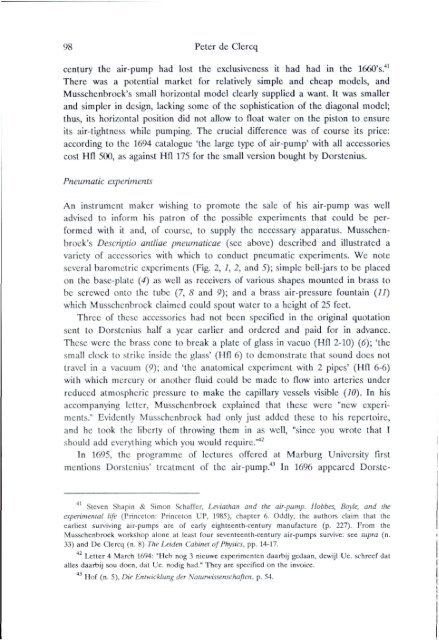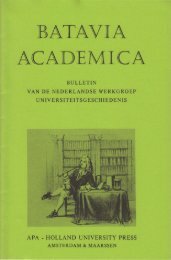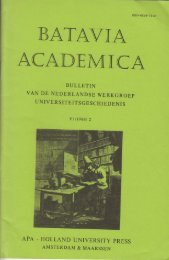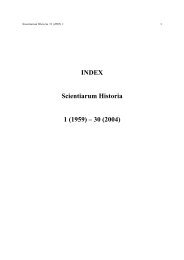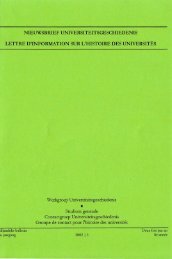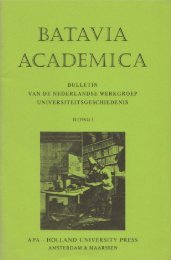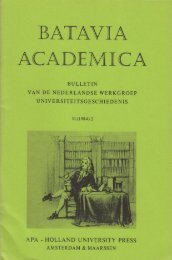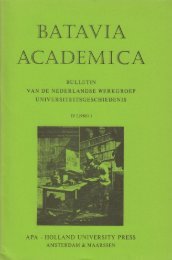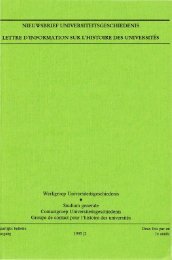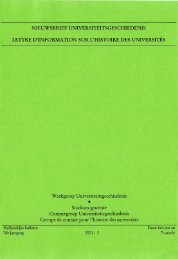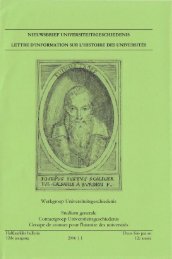EXPORTING SCIENTIFIC INSTRUMENTS AROUND 1700 - Gewina
EXPORTING SCIENTIFIC INSTRUMENTS AROUND 1700 - Gewina
EXPORTING SCIENTIFIC INSTRUMENTS AROUND 1700 - Gewina
You also want an ePaper? Increase the reach of your titles
YUMPU automatically turns print PDFs into web optimized ePapers that Google loves.
98 Peter de Clercq<br />
century the air-pump had lost the exclusiveness it had had in the l(360's.'"<br />
There was a potential market for relatively simple and cheap models, and<br />
Musschenbroek's small horizontal model clearly supplied a want. It was smaller<br />
and simpler in design, lacking some of the sophistication of the diagonal model;<br />
thus, its horizontal position did not allow to float water on the piston to ensure<br />
its air-tightness while pumping. The crucial difference was of course its price:<br />
according to the 1694 catalogue 'the large type of air-pump' with all accessories<br />
cost Hfl 5(X), as against Hfl 175 for the small version bought by Dorstenius.<br />
Pneumatic experiments<br />
An instrument maker wishing to promote the sale of his air-pump was well<br />
advised to inform his patron of the possible experiments that could be performed<br />
with it and, of course, to supply the necessary apparatus. Musschenbroek's<br />
Descriptio antliae pneumaticae (see above) described and illustrated a<br />
variety of accessories with which to conduct pneumatic experiments. We note<br />
several barometric experiments (Fig. 2, 7, 2, and 5); simple bell-jars to be placed<br />
on the base-plate (4) as well as receivers of various shapes mounted in brass to<br />
be screwed onto the tube (7, 8 and 9); and a brass air-pressure fountain (77)<br />
which Musschenbroek claimed could spout water to a height of 25 feet.<br />
Three of these accessories had not been specified in the original quotation<br />
sent to Dorstenius half a year earlier and ordered and paid for in advance.<br />
These were the brass cone to break a plate of glass in vacuo (Hfl 2-10) (6); 'the<br />
small clock to strike inside the glass' (Hfl 6) to demonstrate that sound does not<br />
travel in a vacuum (9); and 'the anatomical experiment with 2 pipes' (Hfl 6-6)<br />
with which mercury or another fluid could be made to flow into arteries under<br />
reduced atmospheric pressure to make the capillary vessels visible (10). In his<br />
accompanying letter, Musschenbroek explained that these were "new experiments."<br />
Evidently Musschenbroek had only just added these to his repertoire,<br />
and he took the liberty of throwing them in as well, "since you wrote that I<br />
should add everything which you would require.'""^<br />
In 1695, the programme of lectures offered at Marburg University first<br />
mentions Dorstenius' treatment of the air-pump.'" In 1696 appeared Dorste-<br />
Steven Shapin & Simon Schaffer, Leviathan and the air-pump. Hobbes, Boyle, and the<br />
experimental life (Princeton: Princeton UP, 1985), chapter 6. Oddly, the authors claim that the<br />
earliest surviving air-pumps are of early eighteenth-century manufacture (p. 227). From the<br />
Musschenbroek workshop alone at least four seventeenth-century air-pumps survive: see supra (n.<br />
33) and De Clercq (n. 8) The Leiden Cabinet of Physics, pp. 14-17.<br />
^ Ixtter 4 March 1694: "lleb nog 3 nieuwe experimenten daarbij gedaan, dewiji Ue. schreef dat<br />
alles daartiij sou dcwn. dat Ue. nodig had," ITiey are specified on the invoice.<br />
^' Hof (n. 5), Die Entwicklung der Naturwissenschaften. p. 54.


